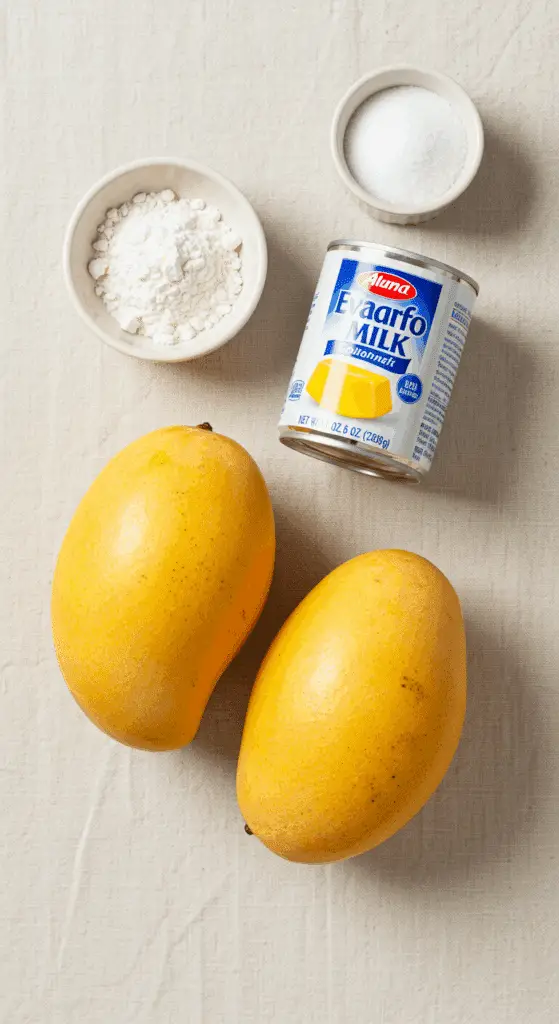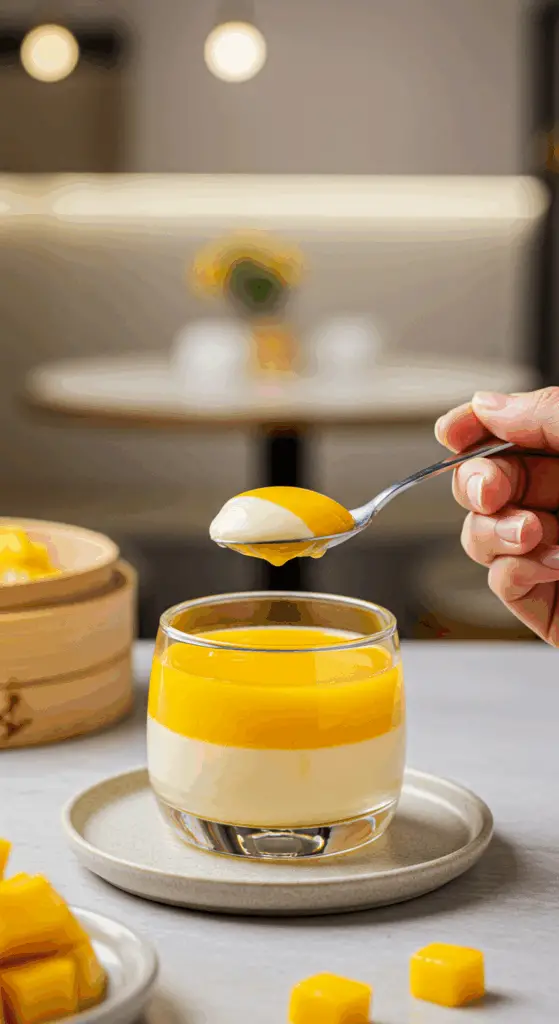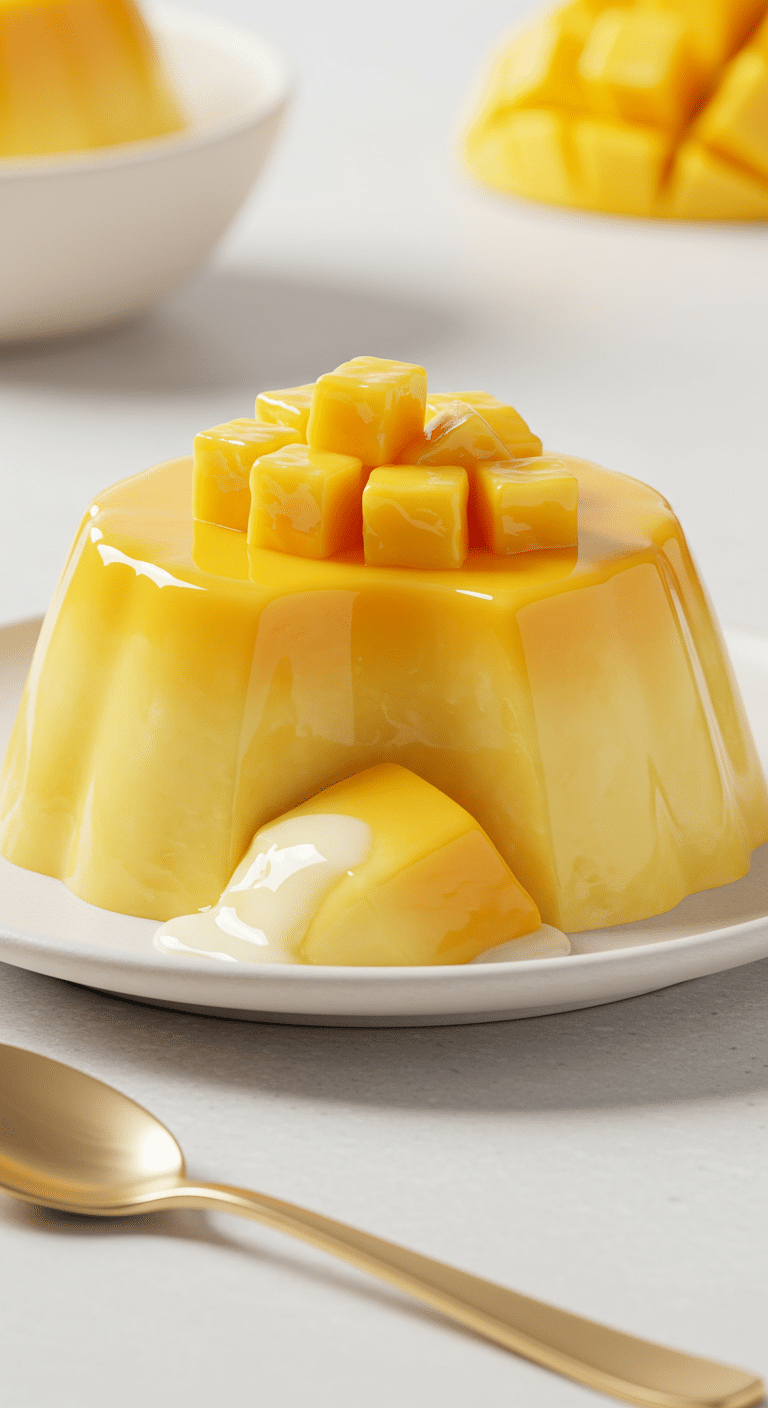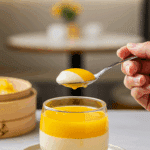Have you ever finished a delicious dim sum meal and been treated to that beautiful, jiggly, and incredibly refreshing mango pudding? That silky-smooth, intensely tropical dessert that acts as the perfect, sweet finale? What if I told you that you can recreate that authentic, iconic Hong Kong-style Mango Pudding at home with just a few simple ingredients?
This isn’t just a recipe; it’s a ticket to one of the most beloved desserts in all of Asia. This classic treat is famous for its impossibly smooth, creamy, and custard-like texture and its pure, unadulterated mango flavor. The secret to the authentic Hong Kong cafe (tong sui) style is the use of evaporated milk, which gives the pudding its signature creaminess. Get ready to master this simple, elegant, and utterly delicious dessert.
Table of Contents
Table of Contents
Recipe Overview: The Ultimate Refreshing Dessert
What makes this Hong Kong-style Mango Pudding a timeless classic is its celebration of the mango. The recipe is designed to let the pure, sweet, and floral flavor of ripe mangoes shine through. The texture, achieved with a simple gelatin set, is incredibly smooth, silky, and delicate. It’s a surprisingly easy, light, and refreshing make-ahead dessert that is perfect for serving after a rich meal or as a cool treat on a warm day.
| Metric | Time / Level |
| Total Time | 4 hours 20 minutes (includes chilling) |
| Active Prep Time | 20 minutes |
| Difficulty Level | Easy |
| Servings | 4-6 |
The Essential Ingredients for Authentic Mango Pudding
This recipe uses a handful of simple but specific ingredients to achieve its signature taste and texture.
- Fresh, Ripe Mangoes: This is the most important ingredient, and the success of the entire dish hinges on their quality. You need the sweetest, most fragrant, and least fibrous mangoes you can find for the smoothest, most flavorful purée.
- Best Varieties: Yellow-skinned Ataulfo mangoes (often sold as Honey or Champagne mangoes) are the absolute best choice for their sweet, honey-like flavor and creamy, non-stringy flesh. Large, round Kent or Keitt mangoes are also fantastic, sweet, and non-fibrous options.
- How to Choose: A perfect, ripe mango will have a wonderful, fruity fragrance at its stem and will yield to firm, gentle pressure (like a ripe peach). Don’t just judge by color!
- Evaporated Milk: This is the secret to the authentic Hong Kong style. Evaporated milk is simply fresh milk that has had about 60% of its water removed through a heating process. This gives it a slightly thicker consistency and a subtly caramelized, concentrated milky flavor that is distinct from fresh milk or heavy cream.
- Unflavored Gelatin: This is what gives our pudding its beautiful, smooth, and jiggly set. We “bloom” the gelatin powder in cold water first, which allows it to dissolve perfectly without lumps, creating a flawless, silky texture.
- Granulated Sugar: Just enough to enhance the natural sweetness of the mangoes. You can easily adjust the amount depending on how sweet your fruit is.

Step-by-Step to Perfect Mango Pudding
Follow these simple, detailed steps to create this elegant and delicious dessert.
Step 1: Bloom the Gelatin
First, let’s prepare our setting agent. Pour the 100g of cold water into a small, heat-safe bowl. Sprinkle the 2 tablespoons of gelatin powder evenly over the surface of the water.
Let the bowl sit, undisturbed, for 5 to 10 minutes. During this time, the gelatin granules will absorb the water and swell, or “bloom,” becoming a firm, jiggly, gel-like puck. This is a crucial step for a smooth final product.
Step 2: Create the Smooth Mango Purée
While the gelatin is blooming, prepare your mangoes. Peel the mangoes and cut the sweet, orange flesh away from the central pit.
Place the 450g of mango chunks into a blender. Blend on high speed until the mango is a completely smooth and vibrant purée.
Pro Tip: If you had to use a mango variety that is a bit stringy or fibrous, it’s a great idea to strain the purée through a fine-mesh sieve into a bowl to remove any fibers. This will guarantee an ultra-silky smooth pudding.
Step 3: Gently Heat to Dissolve the Gelatin
Pour the smooth mango purée into a small pot. Add the 350g of evaporated milk and the 100g of granulated sugar. Stir everything together well.
Now, add the entire bloomed gelatin puck to the pot with the mango mixture.
Transfer the pot to your stovetop and heat the mixture over low-to-medium heat. Stir the mixture occasionally until the gelatin has completely dissolved.
Crucial Pro Tip: Do not let the mixture boil or even get too hot! High heat can weaken or “kill” the proteins in the gelatin, which will prevent your pudding from setting properly. You only need to warm the mixture gently, just enough to fully dissolve the sugar and the gelatin.
Step 4: Chill to Perfection
Once the gelatin has dissolved, remove the pot from the heat. Let the mixture cool slightly at room temperature for about 10-15 minutes.
Carefully pour the mango pudding mixture into your serving containers. You can use small, individual glass bowls, ramekins, or even decorative silicone molds.
Place the pudding cups in the refrigerator and let them chill for at least 4 hours, or preferably overnight, until the pudding is completely firm and set.

The Best Authentic & Easy Hong Kong Mango Pudding
A classic and refreshing Hong Kong-style Mango Pudding. This is a simple, chilled dessert with a smooth, creamy, and jiggly texture. The pudding is made by creating a puree from fresh, ripe mangoes, which is then gently heated with evaporated milk, sugar, and bloomed gelatin until everything is dissolved. The mixture is then poured into individual serving cups and chilled for several hours until it is fully set. It’s often served with a drizzle of evaporated milk and more fresh mango chunks.
- Prep Time: 15 minutes
- Cook Time: 7 minutes
- Total Time: 4 hours 32 minutes (includes cooling and chilling time)
- Yield: 4-6 servings
- Category: Dessert
- Method: Chilling, Blending, Simmering
- Cuisine: Chinese
- Diet: Gluten Free
Ingredients
- 100 g (about ½ cup) cold water
- 2 tablespoons gelatin powder
- 450 g fresh, ripe mangoes, peeled and cut into pieces (about 2 large mangoes)
- 350 g (one 12-oz can) evaporated milk, plus extra for serving
- 100 g (about ½ cup) granulated sugar
- Fresh mango chunks for garnish (optional)
Instructions
- In a small bowl, sprinkle the gelatin powder over the cold water. Let it sit for at least 5 minutes to bloom, until it becomes a firm gel.
- Place the fresh mango pieces in a blender and blend until you have a smooth puree. If your mangoes are fibrous, strain the puree through a fine-mesh sieve.
- Pour the mango puree into a small pot. Add the evaporated milk and granulated sugar, and stir to mix well.
- Add the bloomed gelatin puck to the pot with the mango mixture.
- Place the pot on the stovetop and heat over low-medium heat, stirring occasionally, until the gelatin has completely dissolved. Do not let the mixture boil.
- Remove the pot from the heat and let the mixture cool slightly.
- Pour the pudding mixture into individual serving cups or bowls.
- Chill the puddings in the refrigerator for at least 4 hours, or overnight, until they are fully set.
- Serve chilled, with a drizzle of extra evaporated milk and more fresh mango chunks for garnish, if desired.
Notes
- Blooming the gelatin in cold water before heating is a crucial step to ensure it dissolves smoothly without clumps.
- It is very important not to boil the mango and gelatin mixture, as high heat can weaken the gelatin and prevent the pudding from setting properly.
- The chilling time of at least 4 hours is essential for the pudding to become firm.
Serving Your Hong Kong-Style Pudding
This classic dessert is all about a simple, elegant presentation that lets the beautiful mango flavor shine.
Serve the puddings chilled, directly in their cups. The traditional and most delicious way to garnish is to drizzle a little extra evaporated milk over the top of each pudding and then add a few small cubes of fresh, diced mango. A single fresh mint sprig also adds a lovely pop of color.
Storage and Make-Ahead Tips
This Mango Pudding is the perfect make-ahead dessert for a dinner party or a week of sweet treats.
- Make-Ahead: You can prepare this pudding completely up to 3 days in advance. Keep the individual cups covered with plastic wrap in the refrigerator. For the best presentation, wait to add the fresh mango garnish until just before serving.
- Storage: Store any leftover pudding, covered, in the refrigerator. It will stay fresh and delicious for up to 5 days.
- Freezing: Due to the gelatin set, this pudding does not freeze well. Freezing can damage the delicate protein structure and cause the pudding to become watery upon thawing.
For more recipe follow my Pinterest account
Creative Recipe Variations
This simple and delicious pudding is a wonderful base for other tropical fruit flavors.
- Add a Creamy Coconut Twist: For a more Southeast Asian flavor profile, you can substitute half (or all) of the evaporated milk with an equal amount of full-fat, canned coconut milk. The combination of mango and coconut is a classic and is absolutely delicious.
- Make it a Mango Sago Pudding: For a fun, chewy texture, you can prepare 1/2 cup of small, cooked sago (tapioca pearls). After you have heated and dissolved the gelatin into the mango mixture, let it cool slightly, then gently fold in the cooked sago pearls before pouring the mixture into your serving cups.
- Use a Different Tropical Fruit: This simple pudding method is also fantastic with other tropical fruits that can be puréed easily. Try making a passion fruit pudding or a guava pudding for a different but equally refreshing treat.
Enjoy a Taste of Hong Kong!
You’ve just created one of the most beloved and refreshing desserts from the vibrant world of Cantonese cuisine. This authentic Hong Kong-style Mango Pudding is a perfect harmony of pure, sweet fruit and creamy, silky texture. It’s a simple, elegant, and surprisingly easy dessert that is sure to transport you to a bustling Hong Kong dessert shop with every spoonful.
We hope you love this cool, creamy, and delightful treat!
If you enjoyed making this recipe, please leave a comment below or share it with a friend who loves mango!
Frequently Asked Questions (FAQs)
Q1: What is the difference between this Hong Kong-style Mango Pudding and others?
The key ingredient that defines the classic Hong Kong style is the use of evaporated milk. Many other mango pudding or mousse recipes from around the world use heavy cream, regular milk, or coconut milk. Evaporated milk provides a unique, slightly caramelized, and concentrated milky flavor that is very distinctive and nostalgic for those who have had this dessert at a dim sum restaurant.
Q2: My pudding didn’t set properly. What did I do wrong?
A pudding that doesn’t set is almost always caused by an issue with the gelatin. There are two likely culprits. First, you might have overheated the mixture. Boiling the gelatin will destroy its ability to set. You must only warm the mixture gently until the gelatin dissolves. Second, it’s possible you didn’t use enough gelatin for the amount of liquid, so be sure to measure accurately.
Q3: Can I use frozen mango for this recipe?
Yes, you can absolutely use frozen mango chunks, which makes this a great dessert to enjoy year-round! Simply thaw the mango chunks completely before you blend them into a purée. You may find that you need to add a little extra sugar, as frozen mango can sometimes be less sweet than fresh, perfectly ripe, in-season mangoes.
Q4: How can I unmold my pudding for a fancier presentation?
If you chill your pudding in a lightly oiled silicone mold or a small bowl, you can easily unmold it. To release the pudding, you can briefly dip the bottom of the mold in a bowl of hot water for just 5-10 seconds. Then, place your serving plate on top of the mold and carefully invert them together. The pudding should release cleanly onto the plate.
Q5: Can I make this dessert vegan?
To make this specific recipe vegan would require substituting the three main ingredients. You would need to use a plant-based gelatin substitute like agar-agar (which has different setting properties and needs to be boiled), a dairy-free evaporated milk (like a coconut or soy version), and a plant-based sweetener like agave if you are also avoiding refined sugar.


